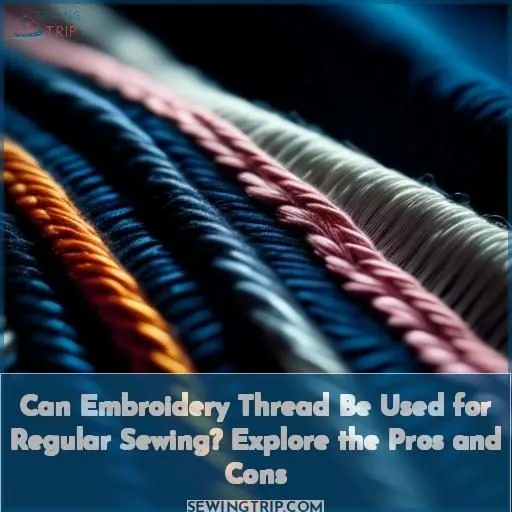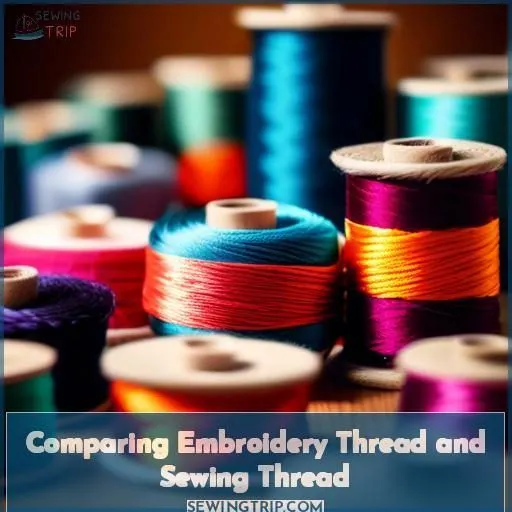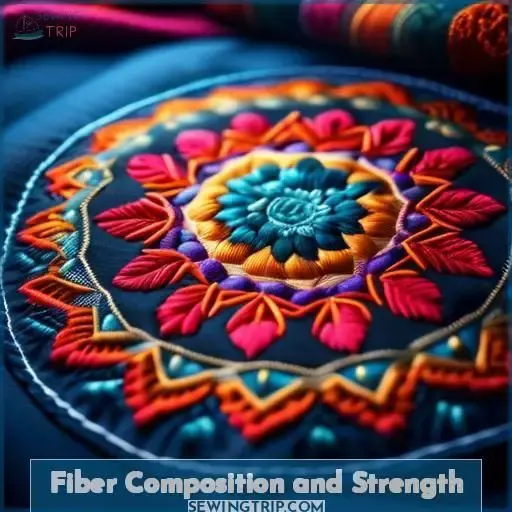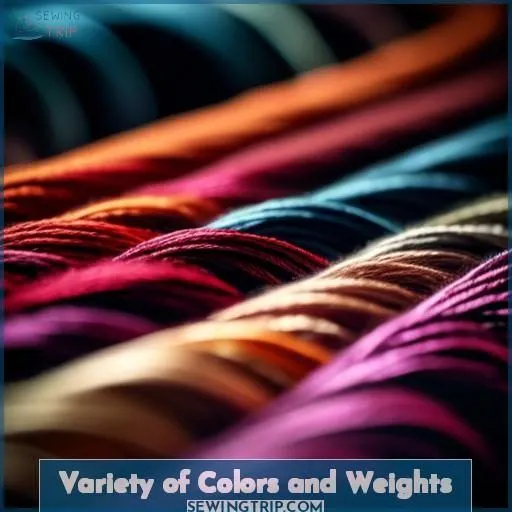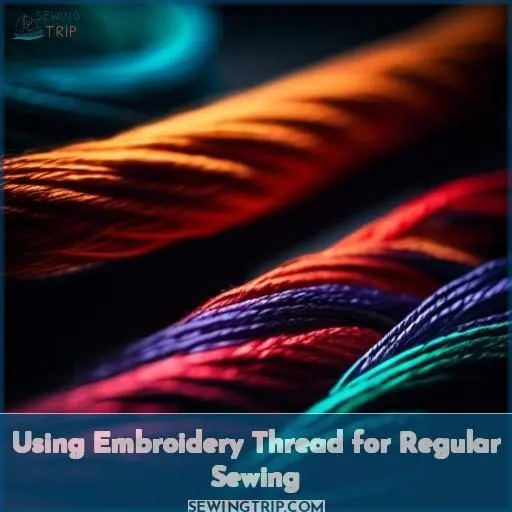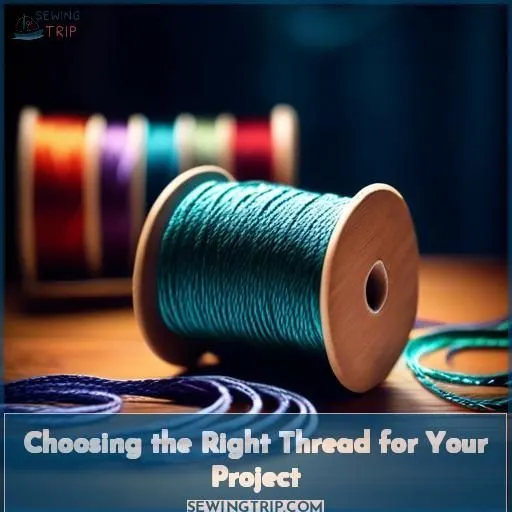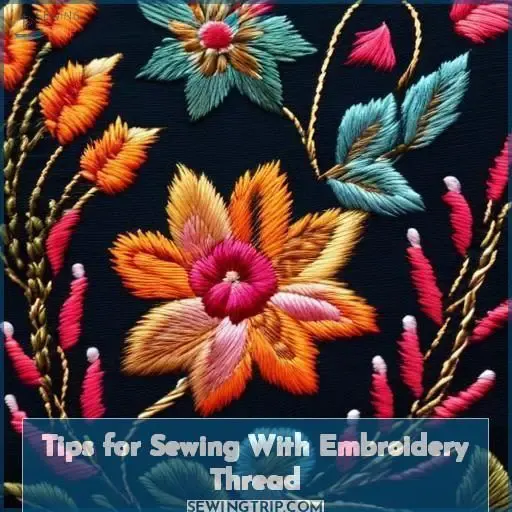This site is supported by our readers. We may earn a commission, at no cost to you, if you purchase through links.
Yes, you can use embroidery thread for regular sewing, but it’s not ideal.
Embroidery thread is typically made from polyester or rayon, which has a looser weave and higher sheen compared to the thicker, more matte cotton sewing thread.
While embroidery thread can add a vintage, textured look to your sewing, it’s more prone to breakage and fraying.
Sewing thread is known for its strength and resilience.
For the best results, it’s generally recommended to use sewing thread for regular sewing projects.
However, if you want to experiment with the unique effects of embroidery thread, keep reading to learn more about when and how to use it effectively.
Table Of Contents
- Key Takeaways
- Can Embroidery Thread Be Used for Regular Sewing?
- Comparing Embroidery Thread and Sewing Thread
- Fiber Composition and Strength
- Thread Characteristics and Sheen
- Variety of Colors and Weights
- Using Embroidery Thread for Regular Sewing
- Choosing the Right Thread for Your Project
- Tips for Sewing With Embroidery Thread
- Frequently Asked Questions (FAQs)
- Conclusion
Key Takeaways
- Embroidery thread is made from polyester or rayon, which has a looser weave and higher sheen compared to sewing thread.
- Embroidery thread is more prone to breakage and fraying than sewing thread.
- Sewing thread is known for its strength and resilience, making it the recommended choice for regular sewing projects.
- If you want to experiment with the unique effects of embroidery thread, it can be used for regular sewing, but proper needle selection and tension settings are essential to prevent shredding.
Can Embroidery Thread Be Used for Regular Sewing?
Embroidery thread can be used for regular sewing.
However, it is not recommended for all sewing tasks.
Embroidery thread is designed to be softer and smoother than sewing thread, which makes it perfect for decorative applications.
It is generally not as strong as sewing thread, which is why it is not recommended for seams or garment construction.
If you are considering using embroidery thread for sewing, it is advisable to test it first to ensure that it holds up to the stress of the project.
Comparing Embroidery Thread and Sewing Thread
Embroidery thread and sewing thread may seem similar, but they have distinct differences. Embroidery thread is typically made from polyester or rayon, while sewing thread is often cotton. The weave of embroidery thread is looser, allowing for more sheen and a wider range of colors.
Sewing thread is thicker and can be used in the bobbin for matching colors. Needle selection and tension settings are essential when using embroidery thread, as it can shred easily. Sewing thread is more durable and suitable for constructing garments, while embroidery thread is meant for embellishment.
Fiber Composition and Strength
Shifting gears from the general comparison, let’s zero in on the muscle of the matter: fiber composition and strength. Regular sewing thread is the gym rat. It’s less prone to thread breakage and fraying, making it a reliable partner for your sewing marathons. Plus, its low lint production keeps your machine purring.
Embroidery thread might flex its vibrant colors, but in terms of heavy lifting, it adds vintage effects with ease. However, it’s the pros of strength and resilience that give regular thread its well-earned reputation.
Thread Characteristics and Sheen
In comparing the sheen of embroidery thread versus regular sewing thread, there are a few key differences to note. Embroidery thread, particularly rayon and silk varieties, often has a high sheen, which adds a glossy finish to embroidered designs. This is due to the materials used in the thread, such as rayon, which is known for its high sheen and smooth texture. On the other hand, regular sewing thread typically has a matte or low-sheen finish, with cotton threads having a slightly rougher texture in comparison.
In terms of compatibility with high-speed machines, embroidery thread is suitable for dense designs, while regular sewing thread is better suited for less dense designs. Additionally, in terms of lint minimization, embroidery thread is designed to minimize lint and shrinkage, making it ideal for machine embroidery.
If you’re seeking to create a vintage look, embroidery thread can be a great choice. For example, Floriani matte finish polyester thread is often used for a vintage appearance. However, if you’re working on a project that requires a wide range of colors and weights, regular sewing thread may be a better option, as it’s available in a variety of colors and weights.
In summary, when comparing the sheen of embroidery thread and regular sewing thread, consider the following:
- Embroidery thread is known for its high sheen, particularly in rayon and silk varieties, which adds a glossy finish to embroidered designs.
- Regular sewing thread typically has a matte or low-sheen finish, with cotton threads having a slightly rougher texture.
- Embroidery thread is suitable for dense designs on high-speed machines, while regular sewing thread is better suited for less dense designs.
- Embroidery thread is designed to minimize lint and shrinkage, making it ideal for machine embroidery.
- Regular sewing thread is available in a wide range of colors and weights, making it a versatile choice for various projects.
Variety of Colors and Weights
Embroidery thread provides a vast array of colors and weights that can enhance your sewing endeavors. Here are some key points to bear in mind:
- Thread weight: Select the appropriate weight for your project. Thicker threads are suitable for heavier fabrics, while finer threads are most suitable for lighter materials.
- Color options: Embroidery thread is available in a wide range of colors, allowing you to match or contrast with your fabric for a unique appearance.
- Design compatibility: The variety of colors and weights guarantees that you can find the ideal thread for your design, whether it’s a simple stitch or an intricate pattern.
- Sheen effects: Some embroidery threads have a matte finish, while others have a high sheen. Consider the desired effect for your project when selecting a thread.
Using Embroidery Thread for Regular Sewing
Embroidery thread can indeed be used for regular sewing, but it’s not always the most suitable option. While embroidery thread is robust and compatible with high-speed machines, it may not be as resilient as typical sewing thread. If you’re contemplating using embroidery thread for regular sewing, you’ll need to be mindful of potential thread breakage and factor in the expense.
You can test your sewing project on scrap fabric to assess the performance of the embroidery thread. Moreover, employing the proper needle and tension settings is pivotal when working with embroidery thread.
Choosing the Right Thread for Your Project
When choosing thread for your project, consider the unique needs and requirements of the garment or item you’re sewing. Take the time to assess the thread’s fiber composition, sheen, and machine compatibility to guarantee that your project turns out exactly as you envisioned.
Thread Selection
When choosing the right thread for your project, consider the needle size, tension adjustment, and thread speed. Test on scrap fabric to understand thread behavior. Rayon embroidery thread isn’t recommended for garment construction.
Use a wire stand to keep thread organized. Test on scrap fabric before using embroidery floss in a project. Use a larger eye size needle for thicker embroidery floss.
Adjust tension setting for embroidery thread to prevent disconnections. Use embroidery floss slowly to prevent disconnections.
Consider using regular thread for garments that will receive stress at the stitching lines.
Project Requirements
Choosing the right thread for your project isn’t just about picking colors; it’s a dance of decisions. Consider embroidery floss for decorative stitching, but remember, the needle size, tension setting, and speed adjustments are your dance partners. Keep your threads tamed with a wire stand and a metallic needle for that top-stitching sparkle.
Machine Compatibility
To guarantee optimal results when utilizing embroidery thread for standard sewing, it’s imperative to evaluate the machine’s compatibility with the thread. Here are some recommendations to assist in selecting the appropriate thread for your undertaking:
- Thread Choice: Opt for a thread appropriate for your machine. Certain threads may not function optimally with specific machines, thus it’s essential to choose a thread compatible with your particular model.
- Project Specifications: Take into account the requirements of your project. If you’re working on an intricate design, you may require a thread capable of handling the increased stitch density without breaking or unraveling.
When utilizing embroidery thread for standard sewing, there are a few points to bear in mind:
- Select a design with reduced stitch density: Embroidery thread is finer than regular sewing thread, hence it may not be suitable for designs with high stitch density. Choose designs with a lower stitch density to prevent thread breaks and unraveling.
- Utilize a matching color in the bobbin: If your machine permits, utilize a matching color in the bobbin to mitigate the risk of thread breaks.
- Test the design on a similar fabric: Prior to using the design on your primary project, test it on a similar or identical fabric to ensure the thread holds up and the design appears as intended.
- Launder the test fabric: If your project will be subject to frequent laundering, launder the test fabric to observe the thread’s reaction to the washing process.
- Anticipate potential thread breaks and unraveling: Despite being designed for machine embroidery, embroidery thread may not be as robust as standard sewing thread. Anticipate potential thread breaks and unraveling, particularly when working on projects with high stitch density or on fabrics unsuitable for embroidery thread.
Tips for Sewing With Embroidery Thread
Now that you’ve chosen the right thread for your project, it’s time to learn how to sew with embroidery thread. Here are some tips to make the process smoother:
- Needle Size: Use a larger eye size needle for thicker embroidery floss.
- Tension Setting: Adjust the tension setting for embroidery thread to prevent disconnections.
- Speed Adjustment: Sew embroidery floss slowly to prevent disconnections.
- Wire Stand: Use a wire stand to keep the thread organized.
Remember to test the thread on scrap fabric before using it in your project to understand its behavior. With these tips, you’ll be able to sew with embroidery thread like a pro!
Frequently Asked Questions (FAQs)
What is the difference between embroidery thread and regular sewing thread?
Aren’t you curious about the thread difference? Embroidery thread offers a vibrant, decorative touch, while regular thread provides sturdy construction. Pick the one that fits your creative vision and sewing needs – no rules, just pure freedom to explore!
Can embroidery thread be used for regular sewing?
You can, but it’s not ideal. Embroidery thread is weaker than regular thread, so stitches may break under stress. Use it for decorative stitching instead of construction.
What are the advantages of using embroidery thread for regular sewing?
You’ll get a beautiful, unique look by using embroidery thread. Its sheen makes stitching pop, and the array of colors let your creativity shine. Just be gentle – it’s not as strong as regular thread.
How does the fiber composition of embroidery thread affect its use in sewing?
Rayon embroidery thread’s delicate fibers make it unsuitable for construction. But polyester embroidery thread’s strength lets you stitch garments worry-free — just test first on scraps.
What are the best practices for using embroidery thread in sewing projects?
Immerse yourself in the embroidery thread pool with precision: regulate tension, employ a durable needle, and stitch gradually for optimal outcomes. Experiment on spare fabric initially to prevent frustrations. Adorn with caution; standard thread prevails for assembly.
Conclusion
When the need arises, embroidery thread can be used for regular sewing.
However, remember, the right tool for the job.
While embroidery thread offers unique textures and colors, sewing with it requires caution due to its tendency to break or fray.
By understanding the pros and cons, you’ll make informed decisions.
This will ensure your projects turn out flawlessly, whether using embroidery thread or the reliable sewing thread designed for the task.

